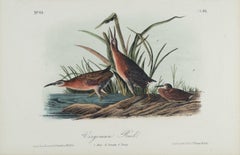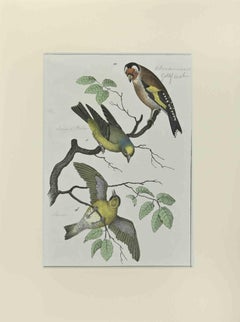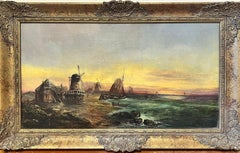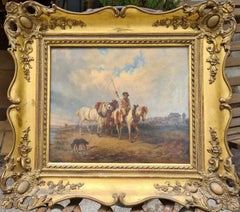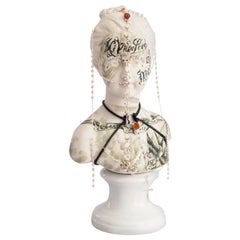Mid-19th Century Art
to
476
4,118
945
361
198
164
Overall Width
to
Overall Height
to
7,472
20,885
158,498
234,387
1,888
2,226
4,759
6,398
5,796
14,858
20,212
25,159
17,338
13,387
5,302
3,076
114
105
23
10
6
5
5
2
1
1
2,852
2,785
49
3,729
1,739
1,319
1,116
883
771
652
440
367
312
293
293
270
256
207
202
188
177
169
167
2,921
1,363
925
721
709
168
108
87
87
87
1,245
3,091
3,129
1,176
Period: Mid-19th Century
Virginian Rail: An Original 19th C. Audubon Hand-colored Bird Lithograph
Located in Alamo, CA
This is an original 19th century John James Audubon hand-colored lithograph entitled "Virginian Rail, 1. Male, 2. Female, 3. Young", No. 63, Plate 311 from Audubon's "Birds of Americ...
Category
Naturalistic Mid-19th Century Art
Materials
Lithograph
Goldfintch - Etching by Johann Friedrich Naumann - 1840
Located in Roma, IT
Goldfintch is an Etching hand colored realized by Gotthilf Heinrich von Schubert - Johann Friedrich Naumann, Illustration from Natural history...
Category
Modern Mid-19th Century Art
Materials
Etching
Signed Antique English Oil Painting Busy Coastal Scene Fishing Boats & Windmills
Located in Cirencester, Gloucestershire
English School, 19th century
signed oil painting on canvas, framed
framed: 16 x 26 inches
canvas: 12 x 22 inches
provenance: private collection, UK
condition: very good and sound con...
Category
Victorian Mid-19th Century Art
Materials
Oil
19th century Ship portrait of the
Located in Woodbury, CT
The former Curator of Oil Paintings at the National Maritime Museum, E H H Archibald, says of Joseph Heard in his Dictionary of Sea Painters in Europe and America that "…with Samuel Walters he must stand as the top-ranking Liverpool ship portraitist of the 19th century." He would have known the artist's work well as the National Maritime Museum has eleven paintings by Heard in its collection.
Joseph Heard was born on 7th March 1799 in Egremont near Whitehaven in Cumberland. His father, also Joseph, was a saddler and it is believed that the aspirant painter received some artistic training from John Clementson who was a local portrait painter. Joseph had a brother Isaac who painted portraits. It is possible that Joseph came across the work of H Collins...
Category
Victorian Mid-19th Century Art
Materials
Canvas, Oil
The Horse Drover, 19th Century Austrian School, Oil on Canvas
Located in Cotignac, FR
A mid 19th Century oil on canvas of horses and their drover. The painting is signed MM, dated 1849 and carries a signature to the stretcher Marie Munch. The painting is presented in ...
Category
Mid-19th Century Art
Materials
Canvas, Oil
Untitled #10 Female antique Bust painted and adorned. Infortunios De La Virtud
By Armando de la Garza
Located in Miami Beach, FL
Untitled #10 (female bust), 2016
from Los Infortunios De La Virtud series
Antique porcelain bust with the intervention of oil, gold, silver, lea...
Category
Romantic Mid-19th Century Art
Materials
Stone, Gold
Americana 1848 pokerwork pyrography panel Prophet or Gospel writer Pennsylvania
Located in Norwich, GB
a wonderful antique pokerwork/pyrography panel by I W Wells, an American artist who flourished between 1845 - 1880. He was active in Pennsylvania/Philadelphia, yet most of his work is conserved in the Pinto Collection, which is part of the Birmingham Museums Trust in the UK. A portrait of Tennyson by Wells is in the Virginia State...
Category
Outsider Art Mid-19th Century Art
Materials
Wood Panel, Etching
British Chalk Pencil Sketch of a Young Calf's Face with Detailed Pink Features
Located in Cirencester, Gloucestershire
John Rabone Harvey ( 1966 - 1922)
graphic and chalk deep green artist paper , unframed
artist paper : 5.5 x 7 inches
Provenance: private collection
Condition: very good condition
Ha...
Category
Realist Mid-19th Century Art
Materials
Chalk, Graphite
Townsend's Rocky Mountain Hare: an Original Audubon Hand-colored Lithograph
Located in Alamo, CA
This is an original 19th century John James Audubon hand colored lithograph entitled "Townsend's Rocky Mountain Hare", No. 1, Plate III, from Audubon's "Quadrupeds of North America",...
Category
Naturalistic Mid-19th Century Art
Materials
Lithograph
"Entrance to the Citadel Cairo": David Roberts' 19th C. Hand Colored Lithograph
Located in Alamo, CA
"Entrance to the Citadel of Cairo" is a 19th century full folio sized duotone lithograph from the Egypt and Nubia volumes of David Roberts’ large folio edi...
Category
Realist Mid-19th Century Art
Materials
Lithograph
A Family of Moorhens & Lilly Pad: A 19th C. Hand-colored Lithograph by Gould
Located in Alamo, CA
This is an original 19th century hand-colored folio-sized lithograph entitled "Gallinula Chloropus" (Moorhen) by John Gould, published in his "Birds of Great Britain", published in London between 1862 and 1873. The print, which was drawn by Gould and Henry Richter and lithographed by Walter & Cohn, depicts a family of Moorhens, including two adults and six babies in a beautiful landscape. The adults are in the water and the babies are lying on the leaves a flowering lilly pad.
This striking Gould hand-colored moorhen family lithograph is augmented with gum-arabic paint. The sheet measures 14.88" high and 21.75" wide. It is in excellent condition, other than a spot in the upper portion of the right margin and two small spots at the edge of the lower margin on the left. The original descriptive text pages from Gould's 19th century publication are included.
There are several other unframed Gould hummingbird lithographs available on our 1stdibs and InCollect storefronts. Two or more of these striking lithographs would make an attractive display grouping. A discount is available for purchase of a set depending on the number. These additional Gould hummingbirds may be viewed by typing Timeless Intaglio...
Category
Naturalistic Mid-19th Century Art
Materials
Lithograph
Le Diable Boiteux - Rare Book Illustrated by Tony Johannot - 1840
Located in Roma, IT
Le Diable Boiteux is an original modern rare book written by René Le Sage (Sarzeau, 1668 – Boulogne-sur-Mer, 1747) and illustrated by Tony Johannot (9 November 1803 – 4 August 1852) in 1840.
Original First Edition.
Published by Bourdin éditeur, Paris.
Format: large 8°.
The book includes 380 pages with several in text and full page illustrations.
Mint conditions.
Tony Johannot (9 November 1803 – 4 August 1852). Johannot was a French engraver, illustrator and painter. His historical paintings were exhibited at the Paris Salon for the first time in 1831. He became an illustrator much prized for his elegance, his diversity, and the lively character of his drawings, which were converted to engravings either by himself or by such artists as Jacques Adrien Lavieille, Émile Montigneul, and Alfred Revel. He was praised by Théophile Gautier.
Category
Modern Mid-19th Century Art
Materials
Paper, Lithograph
Bijinga - Woodcut by Utagawa Kunisada - 1844
Located in Roma, IT
Bijinga is an original artwork realized in the half of the 19th Century by Utagawa Kunisada (1786-1865).
From the series "SHyakunin isshu esho" (Girl's pictures and 100 poets' card...
Category
Modern Mid-19th Century Art
Materials
Woodcut
The Runaways, or Swiss boy on Donkey. Attributed to Joseph Hornung.
Located in Firenze, IT
A couple of young boy and girl, dressed in ethnographic costumes, probably Savoyard, ride a donkey.
The scene takes place in the middle of the countryside with mountains in the back...
Category
Romantic Mid-19th Century Art
Materials
Stainless Steel
$695 Sale Price
40% Off
Evening on River German Master Caucasian Panoramic Landscape 19th century
Located in Stockholm, SE
Attributed Paul Von Franken (1818-1884), famous Gemany a genre and landscape painter, signed bottom right. Fertile scenery coastal town with castle, mosque, minaret, large travelers ...
Category
Realist Mid-19th Century Art
Materials
Canvas, Wood, Oil
"The Doorway of Baalbec": A David Roberts' 19th Century Hand Colored Lithograph
Located in Alamo, CA
"The Doorway of Baalbec" is a 19th century full folio sized duotone lithograph, representing plate 81 in the Egypt and Nubia volumes of David Roberts’ large folio edition, published ...
Category
Realist Mid-19th Century Art
Materials
Lithograph
Lion and snake
Located in PARIS, FR
Lion and snake n°3
by Antoine-Louis Barye (1796-1875)
Bronze sculpture with a nuanced dark greenish brown patina
signed "Barye" on the base
old edition cast – probably from the Bary...
Category
French School Mid-19th Century Art
Materials
Bronze
United States, 1844
Located in Houston, TX
Over 150 year old map of early United States of America with Western Districts from 1844. Original hand color. Districts shown include Hurons, Sioux, Mandans, Osages, and Ozark. Note independent Republic of Texas...
Category
Mid-19th Century Art
Materials
Ink, Watercolor, Handmade Paper
Kabukie - Woodcut by Utagawa Kunisada - 1840
Located in Roma, IT
Kabukie is an original artwork realized in 1840 by Utagawa Kunisada (1786-1865).
Dialogue on stage between the actors Mimasu Gennosuke and Nakamura Shikan as a courtesan.
Signed: ...
Category
Modern Mid-19th Century Art
Materials
Woodcut
Eagle or Horned Owl: A Framed Original 19th C. Hand-colored Lithograph by Gould
Located in Alamo, CA
This is a framed original 19th century hand-colored folio-sized lithograph entitled “Bubo Maximus" (Great Horned or Eagle Owl) by John Gould, from the supplement to his "Birds of Great Britain", published in London between 1862 and 1873. The print depicts an adult Eagle Owl about to feed her brood of babies who are in the their nest. A another adult (possibly the male) is seen in the distant background in the upper right.
This striking framed Gould...
Category
Naturalistic Mid-19th Century Art
Materials
Lithograph
Horse Fair at Donegal
Located in Lexington, KY
Oil on canvas.
Signed, dated 1863
Provenance: Grubbs Auction, June 8, 1984 Christie’s, New York
; Bartlett Burnap
Turner was a British artist who has been referred to as “Horse Fa...
Category
English School Mid-19th Century Art
Materials
Oil
Still Life with Flowers in a White Vase
Located in Milford, NH
A finely detailed still life with flowers in a white vase by American artist George Henry Hall (1925-1913). Hall was born in Manchester, NH, and began his career as an artist at the ...
Category
Mid-19th Century Art
Materials
Canvas, Oil
Child with a Tray (Pear and Bottle) - Original Etching (Guerin #15)
Located in Paris, IDF
Edouard MANET
Child with a Tray (Pear and Bottle), 1861
Original etching
Printed signature in the plate
On Japan paper 36 x 24 cm (c. 12 x 10 inch)
REFERENCES : Catalog raisonne Gu...
Category
Impressionist Mid-19th Century Art
Materials
Etching
"The Towers of Autun" original etching
Located in Henderson, NV
Medium: original etching. This impression on laid paper was printed in London in 1868 for the rare first volume of Philip Gilbert Hamerton's "Etching and Etchers". In addition to bei...
Category
Mid-19th Century Art
Materials
Etching
The Animal Skeleton - Original Lithograph by Paul Gervais - 1854
By Paul Gervais
Located in Roma, IT
The Animal Skeleton is an original lithograph on ivory-colored paper, realized by Paul Gervais (1816-1879). The artwork is from The Series of "Les Troi...
Category
Modern Mid-19th Century Art
Materials
Lithograph
19th century English interior barn scene with a family of goats and baby goats.
Located in Woodbury, CT
This captivating early 19th-century painting of an interior farm scene by Abraham Cooper, circa 1830, is a testament to the artist's skill in capturing ...
Category
Victorian Mid-19th Century Art
Materials
Canvas, Oil
'In Memory of (66)' original Kellogg & Comstock hand-colored mourning lithograph
Located in Milwaukee, WI
The present hand-colored lithograph was produced as part of the funeral and mourning culture in the United States during the 19th century. Before the printmaking boom of the 1830s, however, such inexpensive memorial images were not widely available. These prints became popular as ways of remembering loved ones, an alternative to portraiture of the deceased or to meticulous hand-embroidered memorials often made by female academy students. In the image, the urn-topped monument contains a space where a family could inscribe the name and death dates of a deceased loved one, though this example was never used. In the variations of this image type produced by the Kellogg...
Category
Romantic Mid-19th Century Art
Materials
Lithograph, Watercolor
'Coastal Landscape', Berlin, Paris, Romantic Landscape, Riga, Benezit, Sailing
Located in Santa Cruz, CA
Signed lower right, 'Krause' for Franz Emil Krause (German, 1836-1900) and painted circa 1865.
Displayed in an exceptionally fine, hand-carved, gilt-wood and gesso frame.
Framed Dime...
Category
Mid-19th Century Art
Materials
Canvas, Oil, Board
Fine 19th Century French Oil Painting - Paddle Steamer Ship Choppy Waters
Located in Cirencester, Gloucestershire
Artist/ School: 19th Century French School
Title: A Paddle Steamer in Choppy Waters, period fine quality gilt frame.
Medium: oil painting on canvas, framed
Size: canvas: 21.25” x...
Category
Victorian Mid-19th Century Art
Materials
Canvas, Oil
Paul BRET (1902-1956) Signed Impressionist Oil The Baptistry in Pisa, Italy
Located in Cirencester, Gloucestershire
Artist/ School: Paul BRET (French, 1902-1956), signed
Paul Bret was one of the first French twentieth century artists to work in Greece. He had a studio in ...
Category
Mid-19th Century Art
Materials
Oil
Óleo sobre tela - Milagro en el camino
Located in Sant Celoni, ES
El estado de conservación de la obra es aceptable
Se presenta enmarcada la obra (el marco presenta algunas leves faltas)
Medidas obra: 36 cm altura x 48 cm ancho.
Medidas marco: 4...
Category
Old Masters Mid-19th Century Art
Materials
Oil
19th Century English Yacht on the high sea with a lighthouse in stormy sky's
Located in Woodbury, CT
This maritime scene by Nicholas Matthew Condy, the celebrated English marine painter continues to reveal his deep fascination with ships and the shifting moods of the sea. The compos...
Category
Victorian Mid-19th Century Art
Materials
Oil, Board
“Bucolic Landscape at Sunset”
By Ramsay Richard Reinagle
Located in Southampton, NY
Beautiful luminous painting of a bucolic rural scene in sunset by the English artist, Ramsey Richard Reinagle. Circa 1930. Condition is good. Sig...
Category
Academic Mid-19th Century Art
Materials
Canvas, Oil
$2,240 Sale Price
20% Off
Tp Part with Thee, my Boy - Etching by Thomas Rowlandson - 1817
Located in Roma, IT
Etching and aquatint realized by Thomas Rowlandson in 1817. Plate from "The Dance of Life" by William Combe.
Very good condition.
Thomas Rowlandson (1757-1827) was an english artis...
Category
Modern Mid-19th Century Art
Materials
Etching
For my Own Good and Yours' I'm Bent- Etching by Thomas Rowlandson - 1817
Located in Roma, IT
Etching and aquatint realized by Thomas Rowlandson in 1817. Plate from "The Dance of Life" by William Combe.
Very good condition.
Thomas Rowlandson (1757-1827) was an english artis...
Category
Modern Mid-19th Century Art
Materials
Etching
Genji in the Twelve Months - Woodcut by Utagawa Toyokuni III - 1858
Located in Roma, IT
Genji in the Twelve Months / The Tenth Month (Moto) is a tryptich woodcut print realized by Utagawa Toyokuni III in 1858.
Very good condition except for some minor signs of wear.
Category
Modern Mid-19th Century Art
Materials
Woodcut
Sheep with their Lamb
Located in St. Albans, GB
Edouard Woutermaertens
A wonderful example of one of Belgium's most highly collected animal painters work.
Painted on a beautiful panel it is signed and inscribed by the artist on t...
Category
Barbizon School Mid-19th Century Art
Materials
Oil
Passiflora Cinnabarina, antique botanical Australian flower lithograph print
Located in Melbourne, Victoria
'Passiflora Cinnabarina' (Passionflower)
Botanical lithograph of an Australian native plant with original hand-colouring , 1871, by Walter Hood Fitch (1817...
Category
Naturalistic Mid-19th Century Art
Materials
Lithograph
Les Gens de Justice - Lithograph by Honoré Daumier - 1845
Located in Roma, IT
Lithograph realized by Daumier in 1845, belonging to the Series "Les Gens de Justice"
Table no. 17 of the Series.
Hand monogrammed in the plate.
Very good condition.
Ref. Delteil...
Category
Modern Mid-19th Century Art
Materials
Lithograph
Florida Cormorant /// John James Audubon Ornithology Bird Art Natural History
Located in Saint Augustine, FL
Artist: John James Audubon (American, 1785-1851)
Title: "Florida Cormorant" (Plate 417, No. 84)
Portfolio: The Birds of America, First Royal Octavo Edition
Year: 1840-1844
Medium: Original Hand-Colored Lithograph on wove paper
Limited edition: approx. 1,200
Printer: John T. Bowen, Philadelphia, PA
Publisher: John James Audubon and J.B. Chevalier, New York, NY and Philadelphia, PA
Sheet size: 6.5" x 10.44"
Image size: 3.75" x 6.25"
Condition: Some minor discoloration upper center in margin. In excellent condition with strong colors
Notes:
Provenance: private collection - Cleveland, OH. Lithography and hand-coloring by American artist John T. Bowen (1801-c.1856). Comes from Audubon's famous seven volume portfolio "The Birds of America", First Royal Octavo Edition (1840-1844), which consists of 500 hand-colored lithographs.
Based on a composition painted in the Florida Keys on April 26, 1832, Audubon's forty-seventh birthday.
The double-crested cormorant (Nannopterum auritum) is a member of the cormorant family of water birds. It is found near rivers and lakes and in coastal areas and is widely distributed across North America, from the Aleutian Islands in Alaska down to Florida and Mexico. Measuring 70–90 cm (28–35 in) in length, it is entirely black except for a bare patch of orange-yellow facial skin and some extra plumage that it exhibits in the breeding season when it grows a double crest in which black feathers are mingled with white. Five subspecies are recognized. It mainly eats fish and hunts by swimming and diving. Its feathers, like all cormorants, are not waterproof, and it must dry them out after spending time in the water. Once threatened by the use of DDT, the numbers of this bird have increased markedly in recent years.
To make 'The Birds of America' more affordable and widely available, in 1839 John James Audubon began the first octavo edition, a smaller version of the folio which was printed and hand-colored by J. T. Bowen in Philadelphia. Employing a new invention, the camera lucida, the images were reduced in size, rendered in intermediate drawings by John James Audubon and his son John Woodhouse, and then drawn onto lithographic stones. These miniatures exhibit a remarkable amount of attention to quality and detail, as well as a meticulous fidelity to the larger works. Some compositional changes were made in order to accommodate the smaller format. Like the Havell edition, John James Audubon’s first...
Category
Victorian Mid-19th Century Art
Materials
Watercolor, Lithograph
A Racehorse with Owner and Jockey, 19th Century Equine Oil Painting
Located in London, GB
Oil on canvas
Image size: 25 1/2 x 19 1/2 inches (40 x 50 cm)
19th century gilt pierced frame
This is a wonderful scene featuring a dark bay racehorses mounted by its jockey. The pa...
Category
Victorian Mid-19th Century Art
Materials
Canvas, Oil
Oil Sunset Forest Scene titled "Autumn Sunset"
Located in Fredericksburg, VA
Paul Gottlieb Weber (1823-1916) was a German-American painter renowned for his landscape and genre scenes. Settling initially in Philadelphia from Germany, he quickly gained recognit...
Category
Hudson River School Mid-19th Century Art
Materials
Canvas, Oil
Kiyomizu Temple, Scenes of Famous Places along Tôkaidô Road - Woodblock on Paper
Located in Soquel, CA
Kiyomizu Temple, Scenes of Famous Places along Tôkaidô Road - Woodblock on Paper
Full Title:
Kyoto: Kiyomizu Temple (Kyô Kiyomizudera), from the series Scenes of Famous Places along...
Category
Edo Mid-19th Century Art
Materials
Ink, Rice Paper, Woodcut
Stage 48 of the 53 Stages of the Tokaido - Japanese Woodblock on Rice Paper
Located in Soquel, CA
Stage 48 of the 53 Stages of the Tokaido - Japanese Woodblock on Rice Paper
Woodblock print of clothing vendors by Utagawa Hiroshige (Japanese, 1797-1858). Originally printed in 183...
Category
Impressionist Mid-19th Century Art
Materials
Rice Paper, Woodcut
The Doctor Bird Ready For Injection - Lithograph by J.J Grandville - 1852
Located in Roma, IT
The Doctor Bird Ready For Injection is an original lithograph on ivory-colored paper realized by J.J. Grandville from Scènes de la vie privée et publique des animaux, 1852. Published...
Category
Modern Mid-19th Century Art
Materials
Paper, Lithograph
Schizanthus Priestii, antique botanical white flower engraving
Located in Melbourne, Victoria
Engraving with original hand-colouring. 1834. 230mm by 155mm. From Paxton's 'Magazine of botany and register of flowering plants' by Sir Joseph Paxton.
Category
Naturalistic Mid-19th Century Art
Materials
Engraving
The Three Brothers, Yosemite
Located in Pacific Grove, CA
This early albumen silver print is titled in ink on the front of the mount. Printed before 1876, when Watkins lost his negatives to a creditor, who sold them to his competitor, Isaia...
Category
Mid-19th Century Art
Materials
Silver
Northern Nocturnal Landscape - Oil on Canvas by J.F. Hesse - Mid 19th Century
By Johann Friedrich Hesse
Located in Roma, IT
Northern Nocturnal Landscape is a colored oil painting on canvas realized by Johann Friedrich Hesse in the early XIX century.
Canvas dimensions: cm. 120 x 90
The artwork is hand-s...
Category
Mid-19th Century Art
Materials
Canvas, Oil
Portrait of Berthe Thorwaldsen with bust of Horace Vernet - 1833
Located in Roma, IT
Portrait of Berthe Thorwaldsen with Bust of Horace Vernet is an original modern artwork realized by the Circle of Horace Vernet (30 June 1789 – 17 Januar...
Category
Modern Mid-19th Century Art
Materials
Canvas, Oil
Black-throated Diver: Original 1st Edition Hand Colored Audubon Bird Lithograph
Located in Alamo, CA
An original rare and extremely collectible first edition John James Audubon hand colored royal octavo lithograph entitled "Black-throated Diver", No. 96, Plate 477, from Audubon's "Birds of America". It was lithographed, printed and colored by J. T. Bowen and published in Philadelphia between 1840-1844. It depicts three Black-throated Divers; an adult male (1), an adult female (2) and a young Diver (3). The male sits on the bank, while the young Diver floats in the water and the female watches...
Category
Naturalistic Mid-19th Century Art
Materials
Lithograph
Petunia violacea, antique botanical purple flower engraving
Located in Melbourne, Victoria
Engraving with original hand-colouring. 1834. 230mm by 155mm. From Paxton's 'Magazine of botany and register of flowering plants' by Sir Joseph Paxton.
Category
Naturalistic Mid-19th Century Art
Materials
Engraving
Golden Eagle
Located in Columbia, MO
John James Audubon was born in Haiti in 1785. Most of his childhood was spent in France, where he first took interest in birds and drawing. He came to the U.S. at age 18, and made ma...
Category
Naturalistic Mid-19th Century Art
Materials
Lithograph
$5,040
Veillot's Crested Fireback Birds: 19th C. Hand-colored Lithograph by John Gould
Located in Alamo, CA
This is a remarkable hand-colored folio sized lithograph entitled "Euplocomus Vielloti" (Viellot's Crested Fireback) by John Gould from his monograph "The Birds of Great Asia", publi...
Category
Naturalistic Mid-19th Century Art
Materials
Lithograph
Large French Impressionist Oil Warm Windmill Landscape
Located in Cirencester, Gloucestershire
Artist/ School/ Date:
Douglas Stuart Allen (American/ French 1923-2021)
American born artist from Chicago, retiring to France during his latter years to become a full time painter.
Title: Windmill Landscape
Medium & Size:
oil painting
canvas: 18 x 22 inches
Condition:
the painting is very sound and good.
Provenance:
private collection, France
The painting is for auction with...
Category
Impressionist Mid-19th Century Art
Materials
Oil
19th Century White Chateau Riverside Estate with Boaters Signed French Oil
Located in Cirencester, Gloucestershire
Riverside Chateau
Signed by artist, French circa 1855
Oil painting on canvas, unframed
Canvas: 10.5 x 16 inches
Condition: The painting is in very good condition, with well-preserve...
Category
French School Mid-19th Century Art
Materials
Oil
Les Gens de Justice - Lithograph by Honoré Daumier - 1845
Located in Roma, IT
Lithograph realized by Daumier in 1845, belonging to the Series "Les Gens de Justice"
Table no. 19 of the Series.
Monogrammed in the plate.
Very good condition.
Ref. Delteil 1355
Category
Modern Mid-19th Century Art
Materials
Lithograph
George Clarkson Stanfield (Attributed), Shipwreck
Located in Cheltenham, GB
This mid-19th-century oil painting, attributed to English artist George Clarkson Stanfield (1826-1878), depicts a small vessel approaching a shipwreck, close to the coast. Stanfield ...
Category
Victorian Mid-19th Century Art
Materials
Oil, Canvas
Barbizon School, Fontainebleau landscape with walkers, oil on canvas
Located in Paris, FR
Barbizon School, French circa 1850
Fontainebleau landscape with walkers
Oil on canvas
21.5 x 31 cm
Framed : 32 x 41.5 cm
In good condition, some minor lacks of paintingsdue to a former frame abrasion mainly on the right border and in the lower border (see photographs please)
This landscape is probably a view of the Fontainebleau forest. This type of scene was painted by the Barbizon painters and by Camille Corot.
The village of Barbizon is very close to the forest of Fontainebleau and the painters who lived there, such as Camille Corot, painted the most picturesque views of the spectacular stone quarries. There were also many walkers and hikers in these places, as the artists had made them famous and fashionable.
The author of this charming little painting wanted to depict the wildness of the place and, in contrast, the walkers who made it a pittoresque curiosity.
Although it's difficult to identify or ascribe the work, as there's no signature or other indication, there's a great deal of sensitivity and self-confidence in a very lively touch that heralds Impressionism.
The detail of the barely sketched silhouettes...
Category
Realist Mid-19th Century Art
Materials
Oil
Óleo sobre tela - Viajeros y campesinos junto al pozo
Located in Sant Celoni, ES
La obra no va firmada, es de autor anónimo
Se presenta enmarcada la obra con un marco de la época de la pintura en madera dorada (el marco presenta algunas pequeñas faltas)
El esta...
Category
Old Masters Mid-19th Century Art
Materials
Oil
Phalacrocorax Graculus (Spectacled Cormorant) /// John Gould Ornithology Bird
By John Gould
Located in Saint Augustine, FL
Artist: John Gould (English, 1804-1881)
Title: "Phalacrocorax Graculus (Spectacled Cormorant)" (Vol. 5, Plate 53)
Portfolio: The Birds of Great Britain
Year: 1862-1873
Medium: Original Hand-Colored Lithograph on wove paper
Limited edition: approx. 750
Printer: Walter or Walter & Cohn, London, UK
Publisher: Taylor and Francis, John Gould, London, UK
Reference: Sauer No. 23; Ayer/Zimmer page 261; Wood page 365; Nissen No. IVB 372; Sitwell page 78
Sheet size: 21.63" x 14.75"
Image size: 17.25" x 12.25"
Condition: Has been professionally stored away for decades. In excellent condition with strong colors
Notes:
Provenance: private collection - Aspen, CO. Lithography and hand-coloring by John Gould and English artist Henry Constantine Richter (1821-1902). Comes from Gould's five volume "The Birds of Great Britain", (1862-1873) (First edition), which consists of 367 hand-colored lithographs. Other contributing lithographers were German artist Joseph Wolf (1820-1899) and Irish artist William Hart (1830-1908). "The Birds of Great Britain" is recognized as Gould's greatest work. Gold gilded edges as issued.
The spectacled cormorant or Pallas's cormorant is an extinct marine bird of the cormorant family of seabirds that inhabited Bering Island and possibly other places in the Commander Islands and the nearby coast of Kamchatka in the far northeast of Russia.
Biography:
John Gould FRS (14 September 1804 – 3 February 1881) was an English ornithologist and bird artist. He published a number of monographs on birds, illustrated by plates that he produced with the assistance of his wife, Elizabeth Gould, and several other artists including Edward Lear, Henry Constantine Richter, Joseph Wolf and William Matthew Hart. He has been considered the father of bird study in Australia and the Gould League in Australia is named after him. His identification of the birds now nicknamed "Darwin's finches" played a role in the inception of Darwin's theory of evolution by natural selection. Gould's work is referenced in Charles Darwin's book, "On the Origin of Species".
Category
Victorian Mid-19th Century Art
Materials
Watercolor, Lithograph
